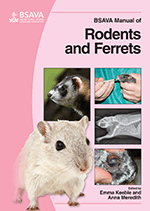
Full text loading...

The gastrointestinal (GI) tract of the domestic ferret has been studied extensively as a model for several human GI tract diseases, including spontaneous gastric and duodenal ulcers, gastro-oesophageal reflux, gastric carcinoma and lymphoma, the lack of acid mucosubstances (similar to humans), and Helicobacter mustelae infection. The clinician must also be aware of GI pain and hydration status accompanying most GI disease. The ferret has a short transit time of 148-219 minutes when fed a meat-based diet. The digestive system is under vagal and sacral innervation and is spontaneously active, even under anaesthesia. Motility can be moderated with atropine. The stomach spontaneously produces acids and proteolytic enzymes, and histamine and vagal stimulation provoke increased secretions. Histamine H2 receptor antagonists abolish the acid secretion response to exogenous histamine or exogenous stimulation with pentagastrin. This chapter observes Anatomy and physiology; Disease of the GI tract; Diagnosis of GI disease; and Treatment of GI disease.
Ferrets: digestive system disorders, Page 1 of 1
< Previous page | Next page > /docserver/preview/fulltext/10.22233/9781905319565/9781905319565.25-1.gif

Full text loading...







